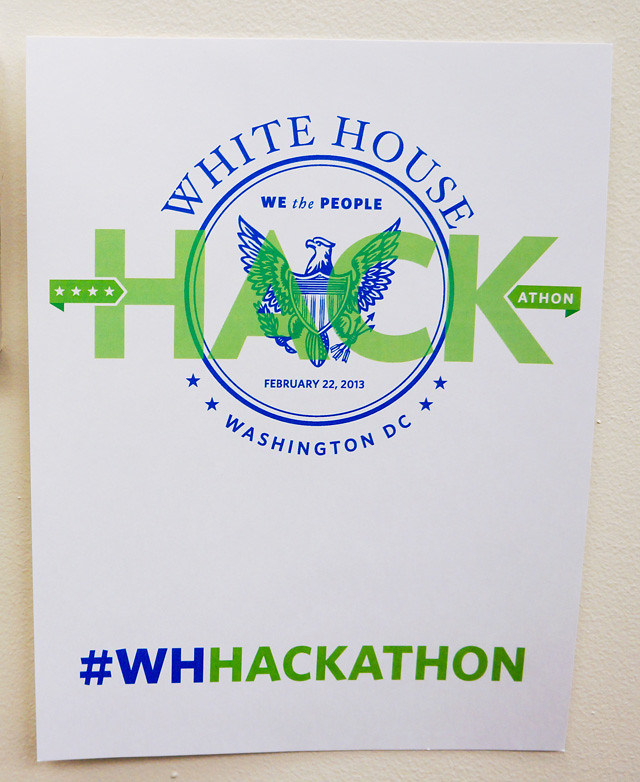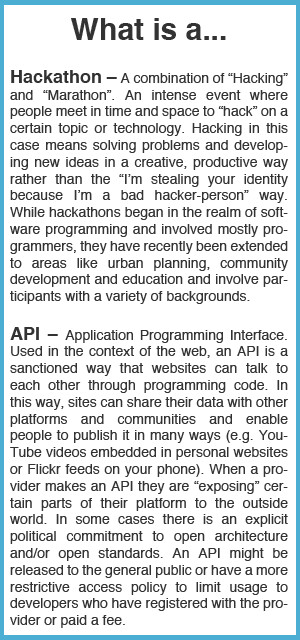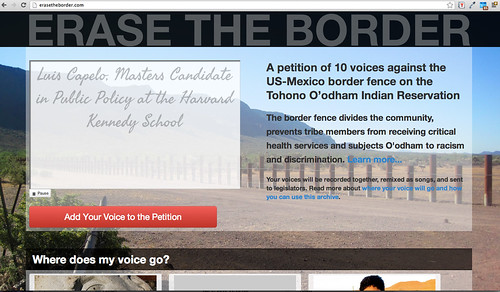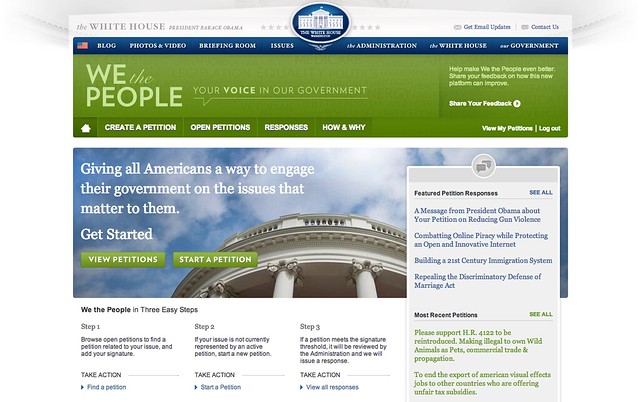
On Friday, February 22nd, 2013, the White House held its first ever hackathon. Twenty-one coders, data scientists, and user experience designers from around the country joined seven members of the White House’s development team to work on the first We the People API. I had the great privilege of participating in this event. (Dude! I went to the White House to hack! Ok, back to journalist voice).
My interest in the platform comes about because of a “voice petition” campaign I’ve been developing for the past few months in conjunction with Ofelia Rivas, an activist on the Tohono O’odham Indian Reservation in southern Arizona. The Tohono O’odham’s land and community was divided by 75 miles of US-Mexico border fence erected in 2008. Although nominally the O’odham are permitted to go back and forth, the O’odham on the Mexican side have serious problems accessing health services, family, and participating in ceremonies due to being detained by border patrol on suspicion of being undocumented migrants. This is having serious effects on the families, health and communities of a people whose culture and traditions were already in danger.
Our site, called Erase the Border, will be launched publicly in the next couple of weeks and invites people to sign a petition by recording their voice. When you sign by adding your voice you are indicating support for putting Tohono O’odham citizenship back on the table as part of comprehensive immigration reform (it was shelved in 2001). Since working on that project, I’ve been doing a lot of thinking about how we can make the petition experience more emotionally resonant and have more impact, so when I saw the opportunity to work on the We the People platform with a bunch of smart people I jumped.
About We the People
So what were we doing at the White House? We the People is an online petition platform on the whitehouse.gov website. It was launched by the Obama White House in Fall 2011. Anyone can start a petition about any topic whether it’s about passing proposed legislation (Pass the DREAM Act!) to solving health problems (Spend more money on research for childhood cancer) to foreign affairs (Recognition of the Armenian Genocide) to the snarky, jokey, kooky and conspiratorial (Admit that these petitions are just going to be ignored ).
If a petition gets more than 100,000 signatures in a one-month period, the White House is obligated to respond. This threshold was originally set at 5,000 signatures and was recently raised from 25,000 signatures. Perhaps because the administration was finding itself in the odd place of having to respond to some of the citizen wackiness like “Secure resources and funding, and begin construction of a Death Star by 2016”. In their now infamous response, the administration declined to pursue Death Star construction due to the prohibitive cost of Death Stars ($850,000,000,000,000,000) and the fact that they do not support blowing up planets. Responses to other petitions, such as Obama’s video response to petitions on gun control in the wake of the Newtown Massacre, have been serious and thoughtful. And still others, such as Gil Kerlikowske’s response to Addressing the Legalization of Marijuana were pretty unsatisfying and seem more like quick copy and paste jobs.
What is most interesting about the platform is that the White House, not usually known as a hotbed of innovation, is experimenting with alternative ways to engage citizens in civic discourse. Of course this works for them – it’s another communications channel to reach the public, they can bypass the press conference form and media filters, they collect email addresses around particular issues, and they do not have to specifically promise anything or do anything other than offer some level of response. There is still a tight level of control here. But it has also opened them up to unexpected (and perhaps not wholly desired) outcomes and that is where things start to get interesting and, to my mind, promising for future developments.

Back to the Hackathon
 The purpose of the We the People hackathon was to bring together a small group of people to test-drive the new API to the We the People platform. We were charged with finding bugs, suggesting features and brainstorming about the creative uses that a petition API from the White House might be put to. The release of an API is a significant addition to this platform. What it means is that companies, advocacy organizations and developers can write programs that display and analyze the We the People petitions and signatures. For example, what if a person standing outside a grocery store could collect petition signatures on their mobile phone? Or what if you really care about gun control and want to receive email alerts about every petition mentioning it? Or you are a researcher wondering about the correlation between signatures and voting patterns? Or you created a petition and simply want a cool petition signature counter to embed on your website? All of these use cases could now be possible with an API and the cultivation of a development community around it.
The purpose of the We the People hackathon was to bring together a small group of people to test-drive the new API to the We the People platform. We were charged with finding bugs, suggesting features and brainstorming about the creative uses that a petition API from the White House might be put to. The release of an API is a significant addition to this platform. What it means is that companies, advocacy organizations and developers can write programs that display and analyze the We the People petitions and signatures. For example, what if a person standing outside a grocery store could collect petition signatures on their mobile phone? Or what if you really care about gun control and want to receive email alerts about every petition mentioning it? Or you are a researcher wondering about the correlation between signatures and voting patterns? Or you created a petition and simply want a cool petition signature counter to embed on your website? All of these use cases could now be possible with an API and the cultivation of a development community around it.
The Office of Digital Strategy, headed by Macon Phillips, instigated the We the People platform and came up with the idea of releasing an API for developers to extend We the People. And in the case of the hackathon event, they did something really smart: they gave us access to the API a week before the event and encouraged us to start sharing our backgrounds, code and ideas in advance of the one-day hackathon. We all introduced ourselves virtually – coders, data scientists, tech folks from Change.org, a founder of github, a reporter from Yahoo.com, an accessibility expert from Filament Group, and more. And numerous developers jumped into ideas and discussion, so that by the time we actually arrived to meet each other in person we knew each others’ github handles and we had a Ruby gem, a Node.js app, and statistical R package to build projects with.
The only structured event of the day was from 5pm – 6pm when we presented our projects to White House staff. Through the rest of the day participants sat in groups of 5-8 around tables in a room on the fourth floor of the Eisenhower Executive Office Building. We were interspersed with members of the White House development team which was convenient for discussing features or learning more about what was going on behind the scenes. People rotated tables frequently looking for collaborators, asking technical questions or sharing visualizations.
The chatty informality of the event was punctuated by visits from high-ranking officials such as Macon Phillips, Director of Digital Strategy, Todd Park, United States Chief Technology Officer, and Steve Van Roekel, United States Chief Information Officer. Indeed it was fascinating to witness a kind of cultural collision between the informal ethos of the hackathon and the formal stateliness of the White House setting. As Van Roekel said in his opening comments to us, “Wow! I’ve never seen so many ties at a hackathon!” And it’s true – we all dressed up at least a little bit although thankfully there were some hoodies and tattoos to be spotted.
The Projects
Confusing the informality-formality thing even further: when the 5-o-clock presentation deadline rolled around a parade of White House staff and officials entered the room with two cases of Miller Lite. Everyone cracked a beer. Well, not me since I’m pregnant, but I truly enjoyed the sight of hackers and political officials toasting their beer cans at the epicenter of executive federal power.
There was a wide range of projects and user scenarios (see the above slideshow). As mentioned previously, a number of folks created useful developer tools like Iqbal Mohomed’s Python library and Jeremy McNally’s Ruby Gem that will help extend the API into different developer communities. Work by Arthi Krishnaswami and Jeff Casimir focused on synthesizing and communicating the API to non-specialists through the creation of curriculum and documentation.
Projects by others focused on data analytics: looking at the whole petition data set and trying to come to conclusions about patterns within that data. For example, Matt Loff’s map visualization correlated petition signatures to voting patterns by county. Yoni Ben-Meshulam created a heat graph of which topics are most and least covered by petitions (Arts and Humanities folks need to step up to the plate, by the way). He also generated a number of word clouds of individual petitions which were fascinating to scroll through. A compelling map by Mick Thompson showed signatures by county for the site’s most signed petition – Legally recognize Westboro Baptist Church as a hate group at 341,355 and counting – to show that most of the support was coming from the Midwest and New England.
Other projects focused on building things for the petition creators and signers. Drew Riley came up with a dashboard to show petition creators how likely their petition was to succeed. I built an embeddable petition mapper which gives the user a choice of mapping their petition by individual signatures or by a heatmap of states that shows where most signatures are coming from. Douglas Back created a copy and paste petition monitor widget. And Erik Ogan from Change.org showed his prototype application which would sync petition signatures from the White House platform to Change.org’s site.
A final group of projects looked at alternative methods of delivery like mobile phones, notifications and email alerts. Rob Eickmann developed a mobile app that built in the concept of favoriting petitions so that you hear when they crossed the signing threshold and when a response is issued. He also brought up some powerful arguments for developing a Write API so that groups in the field could collect petition signatures from people who might not otherwise be able to access the website. And Scott Chacon from Github built a web dashboard where a user can sign up for alerts around issues that they care about so that they are notified when a new petition becomes available for signing.
And that’s where the most “hacker” moment of the day came in.
Scott’s app had an automatic “sign this petition now” button. He demo-ed the button and the app said “Petition Signed” without going to the White House’s site, functionality that the API does not actually expose. The White House staff was slightly disconcerted, “Did that really just sign the petition?” Scott admitted that it did do exactly that. There was a moment of tension – did his app bypass their user login functionality? Did the hackathon result in the actual hacking of their site? Scott replied that it did not – you had to be logged in via the original website. People relaxed and everything was ok again. But for a moment, the spirit of the trickster had infiltrated the halls of power…
To the White House: Don’t stop now!
One of the most interesting things about the day was learning from the White House staff about the challenges of bringing concepts like online petitions, APIs, codesharing, and hackathons to the tightly controlled communication space of the executive office. Even a small thing, like pushing a “commit” to a public source control repository, is an act of communicating with the general public. And the language around APIs says it all – you “expose” things via your API. There is a risk – not of being hacked so long as you’ve got your security right – but of opening your data to unknown applications, unforeseen situations, and future users. It’s a thing I would never imagine the White House to take lightly and, in fact, it is truly somewhat incredible that the White House is about to launch an API.
What I would encourage the White House to do from here is not to stop now when they have innovated so much. There is a way in which the We the People platform could be much more expansive and could actually do much more than what it currently does.
But for the platform to do more the administration would have to slightly change the mission. At the moment the site is geared around the end goal of getting a response. It’s binary – you either reach the number of signatures and get a response or you do not. Either way, after the month is over your petition is over. Got 50,000 signers? There’s no way to get in touch with them. Unsatisfied with the response? You can’t respond. Wondering how you can work on this issue in your local community? No information. You can start another petition but that’s about your only recourse.
Could We the People Support the Civic Process?
So what if the platform were about not just achieving the response goal but about supporting civic dialogue, discourse and organizing along the way? What if We the People was about engaging citizens in the civic process? These petitions can get massive amounts of signatures – thousands, tens of thousands, even hundreds of thousands. That’s a lot of people individually signing onto a particular issue. That’s a meaningful amount of participation. It’s also a lot of people that could be engaged in further action around that issue. The action and dialogue doesn’t have to stop with a response.
What would supporting the civic process look like? At its simplest it would mean allowing petition signers to reach out to and connect with each other in some fashion. To share information about next steps and further actions. There are clearly privacy issues around sharing email addresses – I’m not sure I’d want my email address shared with 71,000 petition signers even if I do agree with them. So connecting people while preserving privacy would be important.
This is an issue that has a recent history. Organizing for Action (and its predecessor Organizing for America) were founded as a way to try to translate the energy, support and massive collection of email addresses during the Obama campaigns into meaningful action on the local level. These organizations are basically non-profit spinoffs of the campaigns’ infrastructure and data. There’s a recognition that data collected for a particular purpose – to get the president elected – could translate into meaningful later civic action. Some of the open questions concern the level of centralization versus decentralization: Who hosts the platform and the data? Who presides over the conversations? What’s their agenda? And this is a longstanding debate in civic media and social movements.
But let’s start with a simple idea. So, just as an example, what about a simple wiki-style webpage associated with each petition? Users who signed the petition would be able to edit the page, add categories and resources, share information about local advocacy efforts and ways to get involved in that particular issue. Other ways of accomplishing the same thing might be a message board for each petition or sharing twitter handles or establishing a petition hashtag or creating a petition facebook page, et al.
During the life of the petition on the We the People site, this wikipage/message board/twitter handle/facebook page would be a way to make visible the myriad efforts that actually go into effecting change at different scales in a democratic society. The key desired outcome no matter the technology would be to connect citizens to each other and empower them to self-organize.
In this way, We the People would value the civic process itself. It would explicitly acknowledge that change comes from both the halls of power and from the streets. It would communicate that change takes time (not just a petition response, though those are helpful). And the White House would play a part in that change by enabling citizens to go further with their cause.

Postscript on the Death Star Petitions: Keep ‘Em Coming
We the People has gotten laughs and critiques for the Death Star petition, the secessionist petitions, the alien conspiracy petitions, the nationalize the Twinkie petition. But you know what? Participation in the platform shot through the roof after the White House released its wildly popular Death Star response – 9.1 million users and counting at the moment. That’s almost 3% of the US population. And who says civic engagement has to be humorless? Part of soliciting open communications with the general public is entertaining the cranks, trolls, jokers, cynics and comedians that make up the general public. Without that variety, We the People would be serious and staid. Kind of like communication with the government usually is…
Check you later – I’m going to sign a petition to extend federal maternity leave to 26 weeks instead of 12 under the Family Medical Leave Act. And then I’m going to sign the one to make Pokemon the state animal of Maryland.



